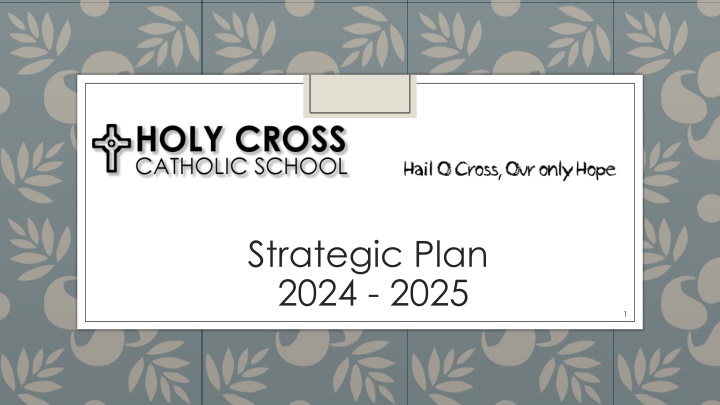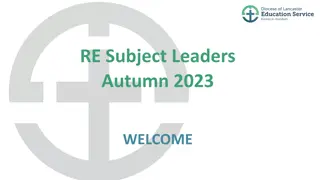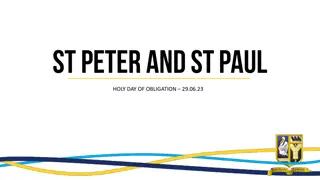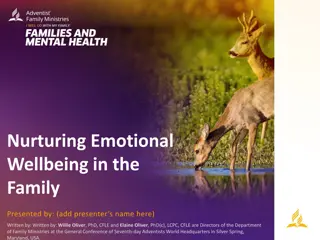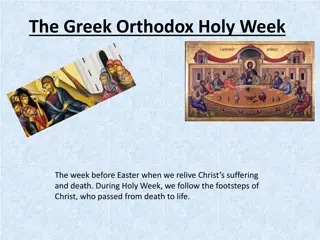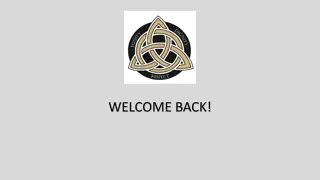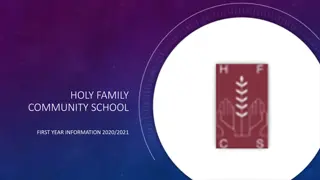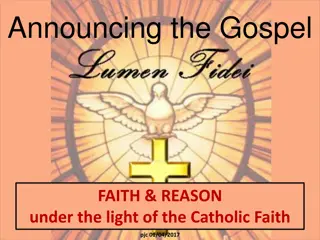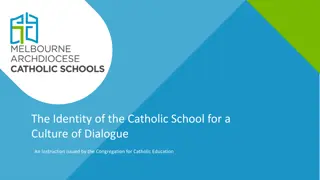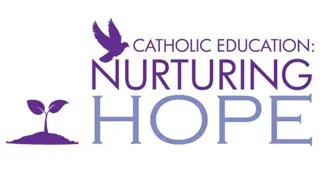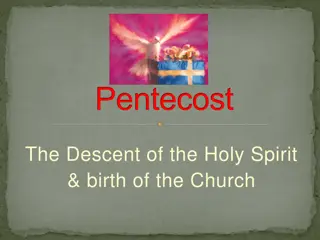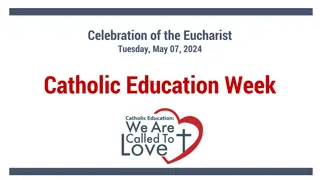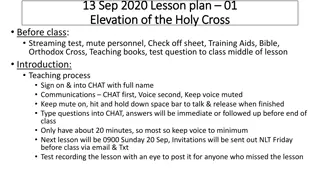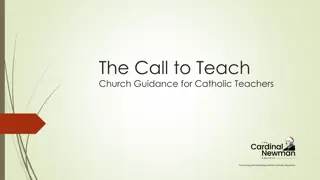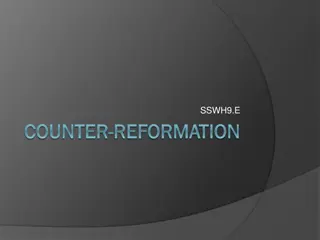Holy Cross Catholic School: Nurturing Faith and Education
Embracing the Catholic values of compassion, service, and reconciliation, Holy Cross Catholic School in New Zealand focuses on nurturing a safe learning environment where students achieve excellence in literacy and numeracy. Through inclusive collaboration and active community engagement, the school upholds its vision of learning and growing in Christ, recognizing and celebrating cultural diversity. With a strong emphasis on Catholic character education and Te Ao Maori, Holy Cross aims to develop future leaders who embody the values of human dignity and love.
Download Presentation

Please find below an Image/Link to download the presentation.
The content on the website is provided AS IS for your information and personal use only. It may not be sold, licensed, or shared on other websites without obtaining consent from the author.If you encounter any issues during the download, it is possible that the publisher has removed the file from their server.
You are allowed to download the files provided on this website for personal or commercial use, subject to the condition that they are used lawfully. All files are the property of their respective owners.
The content on the website is provided AS IS for your information and personal use only. It may not be sold, licensed, or shared on other websites without obtaining consent from the author.
E N D
Presentation Transcript
Strategic Plan 2024 - 2025 1
Our Vision Learning and Growing in Christ Our Strategic Aims Nurturing a safe Catholic learning environment Holistic education with student achievement at 80% in Literacy and Numeracy Active student, parent and community engagement Inclusive collaborative learning Te Ao Maori - Recognising New Zealand s cultural diversity Our Annual Aims Future Leaders Treaty of Waitangi Extend Potential Mahi Tahi Inclusive School Our Technology Collaborative - Inquiry based - Integrated ICT environment Our Values Service Human Dignity Compassion Reconciliation 2
Vision: Learning and Growing in Christ Human Dignity Compassion Reconciliation Service We accept all people created in the image and likeness of God. To acknowledge that we are an expression of God s love for all people so we respond with compassion to the needs of others. To acknowledge that we are made in God s image, therefore we honour each person s rights and responsibility in the light of the common good. To ensure that the Mercy charism of service and stewardship are reflected in all that we do. Luke 1: 29 Matthew 18:22 Matthew 25 31:46 1 Corinthians 13:13 We are called by Christ to love our neighbour as much as you love yourself. How many times should I forgive someone? Jesus answered, Not just seven times but seventy seven times. When I was hungry you gave me something to eat. For now there are Faith, Hope and Love. But of these three, the greatest is Love. 3
Catholic Character Learning and Growing in Christ Catholic Character Holy Cross acknowledges the beliefs and traditions of the Roman Catholic Church. At Holy Cross, every person is equally valued as an image and likeness of God. Every person has the right to a good education that will encourage everyone to utilise their talents to achieve their potential, to celebrate their cultural background and the cultures of others, and to interact positively with others so that genuine peace and unity is promoted in the World. Holy Cross is to be a sign and source of faith. It stands as a living sign of a believing community, a witness to the religious convictions of parents, teachers and parishioners. It is a source of faith for young people to build their lives on together, to be witnesses to the Gospel values. To achieve this the school will: 1. 2. 3. 4. 5. 6. Support children to encounter Christ through prayer, social justice, equity, service and caring for God s creations Nurture practising Catholics who keep alive the traditions and teachings of the Catholic faith Develop and encourage children to be proud of their Catholic faith, to be hopeful and joy filled Provide staff with opportunities to grow on their faith journey through professional development Maintain and develop a progressive programme in Catholic Religious Education for all students Provide pastoral care for students, teachers and the community For now there are Faith, Hope and Love. But of these three, the greatest is Love. 1 Corinthians 13:13 4
Te Ao Mori Recognising New Zealand s Cultural Diversity Treaty of Waitangi Holy Cross Catholic School acknowledges the principles of the Treaty of Waitangi, valuing the bicultural foundations of Aotearoa New Zealand. It acknowledges the Treaty of Waitangi as a covenant and as a Taonga Tapu (sacred treasure). Students will acquire knowledge of Te Reo Maori me ono a tikanga within the context of the Holy Cross Curriculum. The Board of Trustees will ensure all reasonable steps are taken to provide instruction in tikanga M ori and Te Reo M ori for full time students whose parents ask for it. To achieve this the school will: 1. Maintain and develop a progressive programme in Te Reo Maori and tikanga Maori for all students. 2. Ensure the inclusion of aspects of Te Reo Maori and tikanga Maori in teaching of all areas of the curriculum. 3. Reflect the bicultural nature of the school programme and our community in the total school environment and the school wide practice. 4. Gather information which can be used to meet the learning needs of our Maori students and raise achievement by: Core analysis of school wide data in literacy and numeracy. Results of data can be tracked, carefully monitored and used as for trend analysis and to form future teaching. Lead one or two huis to liaise with key community representatives and ensure we hear their voice. Kua tawhiti ke to haerenga mai, kia kore e haere tonu. You have come too far, not to go further. He tino nui rawa ou mahi, kia kore e mahi nui tonu. You have done too much, not to do more. Ta Himi Henare Ngati Hine 1989 5
Te Ao Pasifika Recognising New Zealand s Cultural Diversity Tapasa Cultural Competencies Framework Holy Cross Catholic School acknowledges the need to nurture strong, successful and vibrant Pasifika students who achieve educational success. The Tapasa document provides a strategic direction towards achieving these goals, through principles that can be adopted within our school and wider community. The Board of Trustees will take all reasonable steps towards ensuring Pasifika students are encouraged to be confident and secure in their identities, throughout all curriculum areas. To achieve this the school will: 1. 2. 3. 4. Ensure the inclusion of aspects of Pasifika culture wherever possible, in a range of curriculum areas. Deliberately and systematically utilise a holistic approach to teaching Pasifika children. Engage our community in order to support the specific needs of our Pasifika learners. Reflect the multicultural nature of the students and our community through our school programme, the total school environment and the school wide practice. Gather information which can be used to meet the learning needs of our Pasifika students and raise achievement by: a. Core analysis of school wide data in literacy and numeracy b. Tracking results of data, carefully monitoring and using this for trend analysis and to form future teaching. c. Lead an annual fono to liaise with key Pasifika community representatives. 5. O le tele o sulu e maua ai figota . Through collaboration the most difficult challenges can be overcome. Ruta McKenzie 2010 6
Holistic Education with High Student Success Recognising the Holistic Child when Supporting Excellence New Zealand Curriculum Framework Holy Cross Catholic School acknowledges the holistic nature of students - their mind, body and spirit - when supporting them to succeed to their highest potential. The New Zealand Curriculum document provides strategic direction towards responding to the holistic needs of students, with goals and principles that can be adopted within our school and wider community to support holistic education. The Board of Trustees will take all reasonable steps towards ensuring students holistic needs are acknowledged in our learning programmes. To achieve this the school will: 1. Understand the various aspects of students learning and development - spiritual, cognitive, social, emotional, physical and cultural - are an integrated and interconnected whole. Ensure our school value of Human Dignity, as underpinned by a Whare Tapa Wha model - recognising the aspects of Taha Wairua (Spiritual health), Taha Hinengaro (Mental health), Taha Tinana (Physical health) and Taha Whanau (Family health) - underpins a relevant student-centred curriculum delivery for each student. Support teachers to be equipped with a toolbox of practices that most effectively caters to the needs of students - understanding that every aspect of the environment, resources, relationships, emotional climate, interactions and community are recognised as influential. Regularly gather information and data using effective assessment practices, thereby supporting progress review of students and adaptation of our programmes accordingly, to ensure students holistic needs are being met. 2. 3. 4. Educating the mind without educating the heart is not education at all Aristotle 7
Inclusive Education for All Students Promoting Effective Teaching and Learning while Recognising Excellence Curriculum Levels Framework Holy Cross Catholic School acknowledges the holistic nature of students in supporting them to succeed to their highest potential. The New Zealand curriculum document provides strategic direction towards achieving these goals, through principles that can be adopted within our school and wider community. The Board of Trustees will take all reasonable steps towards ensuring M ori and Pasifika students are encouraged to be confident and secure in their identities, throughout all curriculum To achieve this the school will: 1. Ensure the inclusion of aspects of M ori and Pasifika culture across all curriculum areas. 2. Provide inclusive educational programmes for those students identified with special needs who require adaptation of the curriculum. 3. Provide explicit teaching for students requiring learning support and ensure additional support is available when required. 4. Identify students who need acceleration and extension to ensure their individual needs are met and they reach their full potential. 5. Access outside agencies to provide specialised support for students that meet the specific criteria, ie Speech Language Therapy, Resource Teachers of Learning Behaviours, Moderate Needs, Social Workers in Schools, etc 6. Liaise with parents through hui and fono to ensure students cultural needs are being addressed and provided for in their daily learning. areas. O le tele o sulu e maua ai figota . Through collaboration the most difficult challenges can be overcome. Ruta McKenzie 2010 8
Annual Aims Strategic Aims 1. Nurturing a safe Catholic learning environment 1. Future Leaders: To build the capacity of staff and children to be Future Leaders in Catholic Schools. 2. Extend their full Potential: All akonga particularly, our Maori and Pasifika akonga, are able to access the New Zealand Curriculum through Digital Literacy, as evidenced by achievement in relation to curriculum levels. 3. Partnership: To further develop seamless relationships within our school community by acknowledging our cultural diversity and developing inclusive partnership between school, whanau and Parish. 4. Inclusive School: Teachers are clear about how to work with different cultures understanding of learners with special needs and to use this knowledge to deliver full inclusive teaching programmes. 5. Treaty of Waitangi: Live the principles of the Treaty of Waitangi as a covenant and as Taonga Tapu (sacred treasure). The Board of Trustees will ensure all reasonable steps are taken to provide instruction in tikanga Maori and Te Reo Maori for full time students who parents ask for it. 1. Consistent student achievement at 80% in Literacy and Numeracy, incorporating Digital Literacy 1. Active parent and community engagement a positive and 1. Inclusive collaborative learning to gain a better 1. Te Ao Maori Recognising New Zealand s cultural diversity 9
Principles Christ Centred Our curriculum supports and enhances the faith life of students as a relationship with God the Father, through the son Jesus Christ, in the power of the Holy Spirit. Te Tiriti o Waitangi Holy Cross Catholic Curriculum understands and values the principles of Te Tiriti o Waitangi as the founding document in Aotearoa New Zealand. Broad View of konga Success Holy Cross Catholic Curriculum understands the connection between wellbeing, excellence and outcomes. Inclusion involves positive, inclusive relationships, a sense of belonging for all, and the promotion of diversity as ordinary and expected. High Expectations for all konga Holy Cross Curriculum recognises the strengths, interests, and open-ended potential of every konga. 10
Strategic Goal 1: Nurturing a safe Catholic learning environment Annual Aim 1: Future Leaders Action Plan: Staff Professional Development 2024 2025 Building our Middle Leaders through Professional development with Jacque Allen (Cognition). Embed Middle Leaders effective leadership strategies. All staff will complete a walk through of the Mass with our Parish Priest and Assistant Priest. All staff Spiritual Retreat. Year 3 and Year 4 staff will attend RE curriculum knowledge days so they implement the new RE curriculum. Year 5 and Year 6 Staff will attend RE curriculum knowledge days so they implement the new RE curriculum. Staff attend four Meetings led by DRS and three strand meetings led by CSO. Staff attend four Meetings led by DRS and three strand meetings led by CSO. Some staff will continue undertaking papers to become qualified Level 5 Religious Education. Some staff will continue undertaking papers to become qualified Level 5 Religious Education. 11
Strategic Goal 2: Consistent student achievement at 80% in Reading Annual Aim 2: Extend their full Potential Action Plan: Targeting Achievement 2024 2025 Use the pedagogy of Structured Literacy to inform and direct teacher practice in the Junior School (Year 0 - Year 2). Extend and develop our Structured Literacy approach to include all of Phase 1 of the NZ Curriculum (Year 0 - Year 3) Continue to employ and provide training for Learning Assistants to ensure they can confidently work with Tier 2 and Tier 3 students using a Structured Literacy approach to address specific learning needs. Continue to employ and provide training for Learning Assistants to ensure they can confidently work with Tier 2 and Tier 3 students using a Structured Literacy approach to address specific learning needs. Ensure the Transition to School Programme reflects and informs parents of the Structured Literacy approach. Continue to strengthen the Transition to School Programme with the use of a Structured Literacy approach. Enable professional development opportunities to ensure best practice and a variety of approaches to Reading programmes in the senior school (Years 5 - 8). Continue to provide professional development opportunities to ensure best practice and a variety of approaches to Reading programmes in the senior school (Years 5 - 8). Develop student agency in reading. Students can confidently share where they are and where they need to go with evidence. 12
Strategic Goal 2: Consistent student achievement at 80% in Writing Annual Aim 2: Extend their full Potential Action Plan: Targeting Achievement 2024 2025 Implement the refreshed NZ Curriculum. Embed refreshed NZ Curriculum. Professional development on the new phases of the curriculum, progress outcomes, deliberate acts of teaching, and moderation processes. Revise the local curriculum to ensure it reflects a consistent approach to Writing across the school. Develop student agency in writing. Moderation processes are fully embedded across the school. Deliberate Acts of Teaching are evident in planning and teaching. Common practice is evident across the school. Students can confidently share where they are and where they need to go with evidence. 13
Strategic Goal 2: Consistent student achievement at 80% in Mathematics Annual Aim 2: Extend their full Potential Action Plan: Targeting Achievement 2024 2025 Continue to review and implement the refreshed NZ Curriculum. Embed refreshed NZ Curriculum. Develop teacher content knowledge and effective practice. Develop student agency in mathematics. Students can confidently share where they are and where they need to go with evidence. 14
Strategic Goal 2: Consistent student achievement at 80% in Reading Annual Aim 2: Extend their full Potential Action Plan: Targeting Achievement ACTIONS / MEASURES 2023 baseline 2024 2025 81% within/beyond 85% within/beyond 90% within/beyond All students 86% within/beyond 87% within/beyond 90% within/beyond Maori 80% within/beyond 85% within/beyond 90% within/beyond Pasifika 15
Strategic Goal 2: Consistent student achievement at 80% in Writing Annual Aim 2: Extend their full Potential Action Plan: Targeting Achievement ACTIONS / MEASURES 2023 baseline 2024 2025 73% within/beyond 80% within/beyond 85% within/beyond All students 68% within/beyond 80% within/beyond 85% within/beyond Maori 72% within/beyond 80% within/beyond 85% within/beyond Pasifika 16
Strategic Goal 2: Consistent student achievement at 80% in Mathematics Annual Aim 2: Extend their full Potential Action Plan: Targeting Achievement ACTIONS / MEASURES 2023 baseline 2024 2025 73% within/beyond 80% within/beyond 85% within/beyond All students 75% within/beyond 80% within/beyond 85% within/beyond Maori 71% within/beyond 80% within/beyond 85% within/beyond Pasifika 17
Strategic Goal 3: Active parent and community engagement Annual Aim 3: Partnership Action Plan: Developing relationships 2024 2025 Develop seamless relationships within our school community by acknowledging our cultural diversity and developing a positive and inclusive partnership between school, whanau and Parish. Transition to School programme (Mahi Tahi) Transition to School programme (Mahi Tahi) Hold at least four Maori hui across the year Hold at least four Maori hui across the year Hold at least four Pasifika fono across the year with active committee. Hold at least four Pasifika fono across the year Regular Parent reporting and participation in Parent/Teacher interviews Regular Parent reporting and participation in Parent/Teacher interviews Lead Parish Mass 3 times per year and lead the Holy Communion & Confirmation programmes Lead Parish Mass 3 times per year and lead the Holy Communion & Confirmation programmes 18
Strategic Goal 4: Inclusive collaborative learning Annual Aim 4: Inclusive School Action Plan: Embracing differences 2024 2025 Teachers are clear about how to work with different cultures to gain a better understanding of learners with special needs and to use this knowledge to deliver fully inclusive teaching programmes. Deliver programmes that are inclusive and differentiated to accommodate the needs of children with disabilities Create programmes that embrace cultural diversity, tailored to the learning stages of the students Continue to develop Parent Support groups for children who require additional learning support. Continuous training for staff on cultural diversity Continuous training for staff on meeting the needs of children who require learning support. 19
Strategic Goal 5: Te Ao Maori Recognising the unique position of Maori Culture Annual Aim 5: Our children are proud to be Maori Action Plan: Strengthen the unique position of Maori Culture at Te Kura Ripeka Tapu 2024 2025 Host a hui for parents of Maori children once a term Hold a wh nau Day during the school year Senior Maori students to visit a site of cultural significance in relation to the NZ Histories curriculum Te Reo as part of the planned teaching and learning programmes as part of our local integrated curriculum Effectively embed tikanga Maori protocols Staff to use correct pronunciation of Te Reo Maori 20
